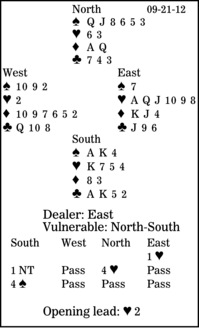Bridge column, September 21: He has one or two; what did he lead?

In today's deal, South is in four spades after East opened one heart. West leads the heart two. East takes the trick with his ace and returns the heart queen. How should South continue?
Yesterday I mentioned transfers into the majors at the two-level. You can stick to that if you prefer. But it is a good idea also to employ Texas transfers, which are jumps to four diamonds or four hearts. Here, when North advances with four hearts, it shows at least six spades (so that an eight-card fit is assured) and a desire either to play in game or to bid a slam, assuming too many controls (aces and kings), are not missing. (To invite a slam, North transfers at the two-level, then jumps to game in his six-card or longer major. Partner moves with a fit in the major and good controls.)
South has 10 tricks: six spades, one heart, one diamond and two clubs. He just must not lose one of them along the way.
East has five or six hearts -- which? Look at West's lead. It is the two -- a singleton. (With a doubleton, West would have led his higher card.) So, at trick two, if South plays his king, it will be ruffed. And then if West shifts to a diamond, the contract fails.
Instead, South should play a low heart from his hand at trick two. Suppose East leads a third heart. Again South plays low. He ruffs on the board, draws trumps, and takes those 10 tricks.
** ** **
COPYRIGHT: 2012, UNITED FEATURE SYNDICATE
DISTRIBUTED BY UNIVERSAL UCLICK FOR UFS

